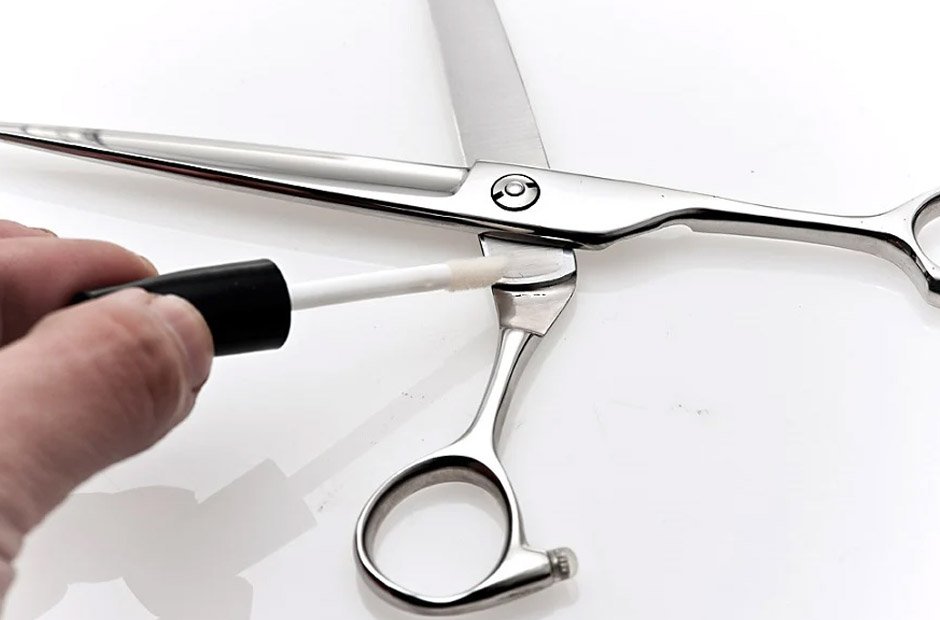Barber scissors are vital tools for barbers and stylists, enhancing precision and control in haircuts. Quality scissors improve comfort and efficiency, minimizing hand fatigue. This blog post will discuss their maintenance, anatomy, and care techniques, offering a comprehensive guide to keeping them in top condition for successful hairstyling.
Types of Barber Scissors and Their Uses
Barber scissors come in various types, each designed for specific purposes. Understanding the different kinds of scissors and their uses can help stylists choose the right tool for the job and maintain them effectively.
The most common type is the cutting scissors, often referred to as barber shears, which feature sharp blades designed for general cutting tasks. These scissors are versatile and suitable for most hair types, making them a staple in any stylist’s toolkit. They excel in delivering smooth, precise cuts, ensuring hair is evenly trimmed without causing split ends.
Thinning scissors, on the other hand, are equipped with one serrated blade and one straight blade. They are perfect for adding texture and reducing bulk in thick hair, creating a more natural look. Stylists often use thinning scissors to blend layers seamlessly and soften harsh lines, giving hairstyles a softer, more refined appearance.
Texturizing scissors, similar to thinning scissors, are used to add movement and volume to hairstyles. However, they have wider teeth, allowing them to remove larger sections of hair in a single snip. These scissors are ideal for creating choppy, layered styles and adding dimension to flat hair.
Understanding the Anatomy of Scissors
To properly maintain barber scissors, it’s crucial to understand their anatomy. Familiarity with the different parts of scissors enables stylists to identify potential issues and perform maintenance tasks with confidence.
The blades are the most critical component, responsible for cutting hair cleanly and efficiently. High-quality scissors feature precision-ground blades made from durable materials like stainless steel or cobalt alloy, ensuring long-lasting sharpness and resistance to corrosion.
The pivot point is where the two blades intersect and are held together by a screw or tension knob. This area is essential for maintaining smooth, even cutting action. Proper tension adjustment is vital, as loose or tight blades can lead to uneven cuts and increased wear.
Handles are designed for ergonomic comfort, allowing stylists to maintain a secure grip while minimizing hand fatigue. Modern scissors often feature finger rests and offset grips to provide additional support and reduce strain during prolonged use.
Understanding these components equips stylists with the knowledge needed to care for their scissors effectively, ensuring they remain in optimal condition for years to come.
Proper Care and Maintenance Techniques
Maintaining barber scissors is an essential aspect of ensuring their longevity and performance. By implementing a routine care regimen, stylists can keep their scissors in top condition and avoid costly replacements or repairs.
Cleaning and Oiling
Regular cleaning is crucial to prevent the buildup of residue and maintain the scissors’ sharpness. After each use, gently wipe the blades with a soft cloth to remove hair and product residue. For a more thorough cleaning, use a mild soap and warm water solution. Dry the scissors thoroughly to prevent rust formation.
Oiling the pivot point is another vital maintenance step. A drop of scissor oil applied to the screw or tension knob will keep the blades moving smoothly and reduce friction, extending their lifespan. Regular oiling also protects the metal from corrosion, ensuring the scissors remain in excellent condition.
Adjusting Tension
Proper tension adjustment is key to maintaining the scissors’ performance. Blades that are too loose may cause hair to slip between them, resulting in uneven cuts, while overly tight blades can lead to increased wear and discomfort. To adjust tension, turn the screw or tension knob until the blades move smoothly without wobbling.
Storage Best Practices
Storing scissors correctly is crucial for preventing damage and maintaining their sharpness. Always store scissors in a protective case or pouch when not in use, keeping them away from other tools that could cause nicks or scratches. Avoid exposing scissors to excessive humidity or direct sunlight, as these conditions can lead to rust or fading.
Signs Your Scissors Need Professional Servicing
Despite regular maintenance, there may come a time when barber scissors require professional servicing. Recognizing the signs that your scissors need attention can prevent further damage and ensure they continue to perform optimally.
One common indicator is difficulty cutting through hair, even after adjusting tension and cleaning. This may suggest that the blades have lost their sharpness and need professional sharpening. A skilled technician can restore the blades to their original condition, ensuring clean, precise cuts.
Uneven cutting or snagging is another sign that your scissors need servicing. This issue can result from misaligned blades or burrs along the cutting edge. A professional technician can diagnose the problem and realign the blades, restoring their smooth cutting action.
Finally, if your scissors feel stiff or resistant when opening and closing, it may indicate an issue with the pivot point. A technician can inspect the screw or tension knob and make any necessary adjustments or repairs to restore smooth movement.
The Longevity of High-Quality Scissors vs. Cheap Alternatives
When choosing barber scissors, it’s essential to consider the balance between cost and quality. While inexpensive scissors may seem appealing, their performance and durability often fall short compared to high-quality alternatives.
High-quality scissors are crafted from superior materials, such as stainless steel or cobalt alloy, which provide excellent sharpness and resistance to corrosion. These scissors are designed for long-term use, ensuring consistent performance and reducing the need for frequent replacements.
Cheap scissors, on the other hand, are often made from lower-grade materials that dull quickly and are prone to rust. Their construction may lack the precision and ergonomic design found in higher-quality options, leading to discomfort and reduced performance over time.
Investing in high-quality scissors ultimately saves money in the long run, as they require fewer replacements and less frequent professional servicing. Additionally, their superior performance allows barbers and stylists to deliver exceptional results, enhancing their reputation and client satisfaction.
Conclusion
Now that you have a better understanding of the components and maintenance techniques for barber scissors, you can confidently choose and care for your shears to ensure their longevity and optimal performance. Remember to clean and oil them regularly, adjust tension as needed, and store them properly.
















